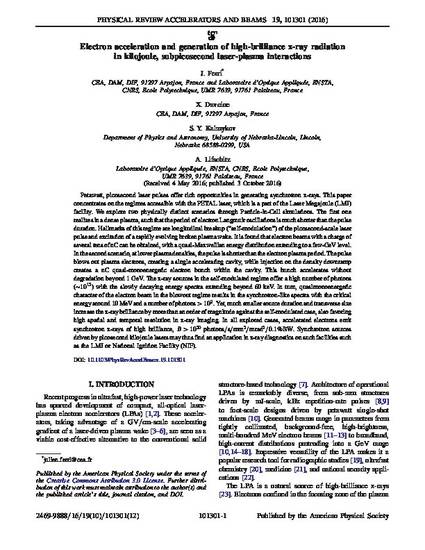
Article
Electron acceleration and generation of high-brilliance x-ray radiation in kilojoule, subpicosecond laser-plasma interactions
Physical Review Accelerators and Beams
(2016)
Abstract
Petawatt, picosecond laser pulses offer rich opportunities in generating synchrotron x-rays. This paper concentrates on the regimes accessible with the PETAL laser, which is a part of the Laser Megajoule (LMJ) facility. We explore two physically distinct scenarios through Particle-in-Cell simulations. The first one realizes in a dense plasma, such that the period of electron Langmuir oscillations is much shorter than the pulse duration. Hallmarks of this regime are longitudinal breakup (“self-modulation”) of the picosecond-scale laser pulse and excitation of a rapidly evolving broken plasma wake. It is found that electron beams with a charge of several tens of nCcan be obtained, with a quasi-Maxwellian energy distribution extending to a few-GeV level. In the second scenario, at lower plasma densities, the pulse is shorter than the electron plasmaperiod. The pulse blows out plasma electrons, creating a single accelerating cavity, while injection on the density downramp creates a nC quasi-monoenergetic electron bunch within the cavity. This bunch accelerates without degradation beyond 1 GeV. The x-ray sources in the self-modulated regime offer a high number of photons (∼10^12) with the slowly decaying energy spectra extending beyond 60 keV. In turn, quasimonoenergetic character of the electron beam in the blowout regime results in the synchrotron-like spectra with the critical energy around 10 MeV and a number of photons> 109.Yet, much smaller source duration and transverse size increase the x-ray brilliance by more than an order of magnitude against the self-modulated case, also favoring high spatial and temporal resolution in x-ray imaging. In all explored cases, accelerated electrons emit synchrotron x-rays of high brilliance, B > 10^20 photons/s/mm^2/mrad^2/0.1%BW. Synchrotron sources driven by picosecond kilojoule lasers may thus find an application in x-ray diagnostics on such facilities such as the LMJ or National Ignition Facility (NIF).
Keywords
- Picosecond lase pulse,
- Petawatt,
- PETAL,
- Synchrotron radiation,
- Laser wakefield,
- Self-modulation,
- Blowout
Disciplines
Publication Date
Fall October 3, 2016
DOI
10.1103/PhysRevAccelBeams.19.101301
Citation Information
J. Ferri, X. Davoine, S. Y. Kalmykov, and A. Lifschitz, Electron acceleration and generation of high-brilliance x-ray radiation in kilojoule, subpicosecond laser-plasma interactions, Phys. Rev. Accel. Beams 19, 101301 (2016)
Creative Commons license

This work is licensed under a Creative Commons CC_BY International License.
